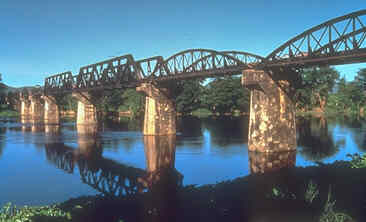|
The Thai-Birma railroad began in Pong Ban
in Thailand and ended in Thanbyuzayat in Birma and was 415 km
long [1]. 5 years the British have built already before the 2nd
world war at the railway [2]. Under Japanese 68,000 Allied Prisoners
of War and 200,000 native compulsion workers finished the total
distance within only 16 months. 96,000 did not survive the forced
labor in the murderous jungle, from that, 16,000 Allied Prisoners
of War [1]. Near Konyu-Hintu died alone 700 Prisoners of War,
in order to beat a route of 5 kms in only 12 weeks into a mountain
covered by the jungle. For commemoration of this act of barbarism
in April 1987 the "Hell-Pass-Memorial" donated by the
Australian government and the Australian Birma Chamber of Commerce
were erected [1].
From the end points the two teams worked one's way forward and
then met in Konu in Thailand, close to the Three Pagoden Pass,
on October 17th, 1943 [2].
 Forced laborer building the Thai-Birma
railroad [2]
Forced laborer building the Thai-Birma
railroad [2]
The railway was constructed with a minimum
to machines and a maximum at human physical strength. In order
to carry out a bursting in the rock punctures were drilled in
the ground and provided with a charge dynamite. Then the compulsion
work must climb down at the cable in order to ignite the fuse.
They had then to climb up fast again, in order to come off from
the field of bursting [1].
 The bridge over river Kwai Yai [2]
The bridge over river Kwai Yai [2]
The bridge was situated 4 kilometres north
of the center of the Kanchanaburi and spanned the river Kwai
Yai. The bridge was brought by the Japanese army from Java and
assembled at the river Kwai Yai by Prisoners of War [1]. The
bridge was not made by bamboo stems as shown in the movie of
1957 "The River Kwai Bridge" but it was a steel structure.
|

|